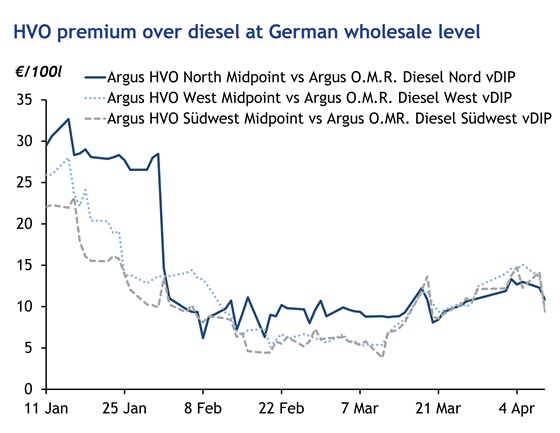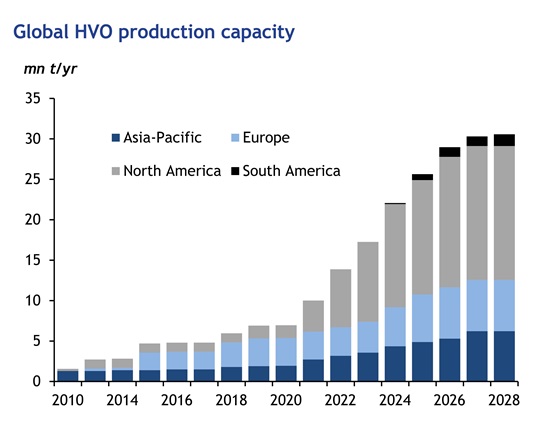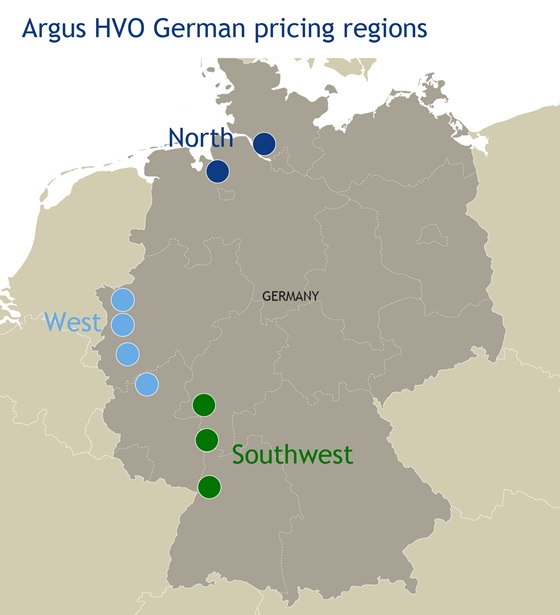
HVO in Germany: Blooming despite the challenges?
Germany will soon permit the unrestricted sale of HVO100 at filling stations. Many market participants see this as a milestone that will enable the German market for unblended HVO to take off. But there are several obstacles to making this a reality.
Hagen Reiners, editor of Argus German Fuels, explores what is driving demand for renewable diesel and the challenges the industry faces.
Some consider HVO to be the first “real” chance to save CO2 in heavy duty transport. HVO, also known as renewable diesel, is chemically identical to conventional road diesel and can be used as a “drop-in” fuel to replace fossil fuel diesel. While other countries have led in HVO adoption, Germany — the single biggest European consumer of diesel — could have the potential to take HVO consumption to the next level.
What may impact the HVO market ramp-up in Germany?
Price
German retailers agree that for HVO100 to be successful with private end-users, the price premium of HVO to diesel needs to be low. If the cost is too high, end-users may stick to diesel as the cheaper option. Forecourt operators believe that for a serious uptick in private HVO demand, the difference to diesel would need to be less than €5/100 litres. But right now, prices are at a premium around €10/100l, according to Argus assessments of wholesale prices (point of truck loading)

Source: O.M.R. Fuels
Just in 2024, the HVO premium to diesel has shown a wide range of volatility – including a relatively low premium for several weeks. This reflects trends in the wider northwest European HVO market, as well as shifting German GHG savings certificates prices. Northwest European HVO supply outweighed demand at the start of the year, with Sweden’s decision to cut domestic road emissions targets for 2024-26 leading to an increase in HVO entering the ARA hub. Lower HVO prices have incentivised blending of the renewable diesel in some markets, eating into European supply as imports from Asia slowed, with the ongoing EU anti-dumping investigation on Chinese biofuels and high freight costs stunting activity on the China-ARA route. This has, in turn, seen the fob ARA range HVO premium rebound in March and April, much more quickly than that for trucks loading in Germany. This is because some German importers were still selling HVO bought in February and because GHG savings prices increased. Sellers were able to offset higher value GHG certificates generated through HVO against their HVO sales price.
Global demand and supply
Demand for HVO and HVO feedstocks such as used cooking oil (UCO) and animal fats is on the rise. In the EU, member states are broadly making progress towards the bloc's increased emissions savings ambitions, notably under the revamped Renewable Energy Directive (RED III), which targets a 29pc share of renewables in final energy consumption in transport by 2030. And changes to national mandates could prompt a more immediate increase in biofuels blending. For example the Netherlands recently approved and retroactively increased the renewable energy annual obligation to 28.4pc from 19.9pc for 2024, and to 29.4pc from 21pc for 2025.
Demand for HVO feedstock used cooking oil (UCO) is also increasing rapidly, with a growing share of the waste raw material being used to produce sustainable aviation fuel (SAF). Argus consulting estimate global UCO availability to be around 8.9mn t in 2024. Global collection sits at a 57pc, with a large portion of theoretical availability around the world not currently collected. UCO availability is expected to increase to 10.8mn t by 2030 as populations and the share of urban areas increase throughout the world.
Big demand potential meets growing supply
Germany consumes around 33mn t/yr of diesel, while global HVO production is projected to reach 22mn t in 2024. With most production added in North America, the overall availability of HVO might also be a limiting factor to a large-scale German switch from fossil diesel to HVO. German distributors estimate that HVO100 sales in Germany were at 50,000-60,000t in 2023 — a far smaller amount compared with Germany’s diesel consumption — and yet importers are registering rising figures for this year.

Source: Argus Biofuels Outlook
Infrastructure
Germany produces hardly any HVO and so relies on imports via the Rhine river and seaports in the north. Every month companies are repurposing more individual diesel tanks at import terminals for HVO100. But if demand was to pick up significantly the import structure may limit supply, supporting HVO premiums to diesel.

What’s driving demand for HVO100 in Germany?
First real option to save CO2 in heavy duty transport
The main buyers of HVO in Germany are companies operating truck fleets looking to lower their CO2 emissions. For several reasons, electrification remains a challenge in this sector while, HVO is the first viable opportunity to reduce CO2 emissions without having to replace engines.
Future growth opportunities
Several distributors and major oil companies are investing in HVO production and infrastructure as they believe HVO demand will continue to rise, albeit not drastically, in the short-term future. One basis for an increase in HVO demand in Germany is the national greenhouse gas (GHG) emissions reduction mandate, which will increase to 25 % by 2030 from 9.35 % in 2024. This quota regulates the share of CO2 companies need to compensate for when selling diesel and gasoline at the wholesale level. Selling HVO is one way to generate GHG savings certificates for this purpose and is therefore an additional revenue stream to the mere product margin.
Despite the challenges, HVO100 will (eventually) be part of the fuel mix
It is unlikely that German HVO consumption will increase drastically in the short term given the lack of infrastructure now. However, it seems realistic to assume that in the mid and longer term HVO100 will have a relevant share in Germany’s transportation fuels mix as its rising application in heavy duty transport continues. But sufficient supply will be key for keeping the premium of HVO to diesel at a low level and thereby incentivising demand.
Argus’ editorial coverage and suite of independent HVO prices for ARA barge loading and for truck loading in Germany provide a comprehensive picture of the European and German market. Both offer the opportunity to price HVO at its fair market value.
Learn more about HVO and our leading coverage of this increasingly important market. Visit the Argus HVO hub.
Author: Hagen Reiners, Editor, Oil Products

